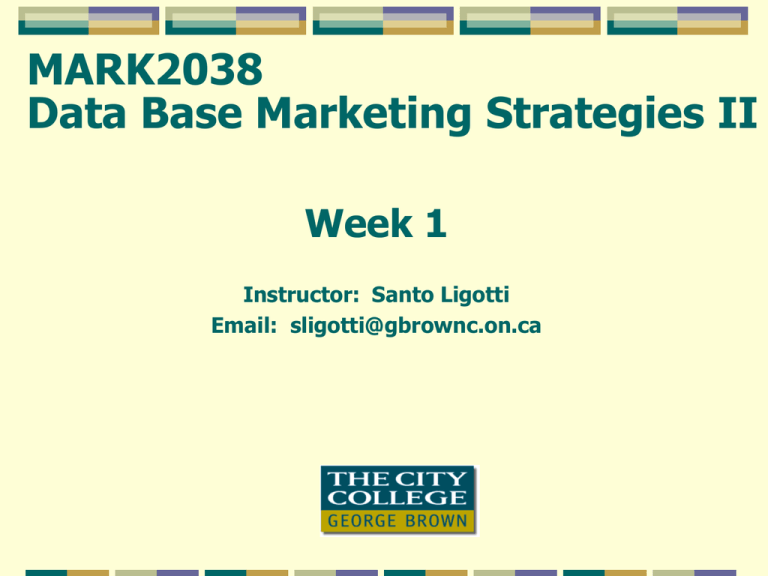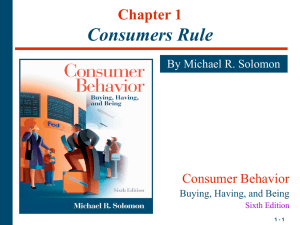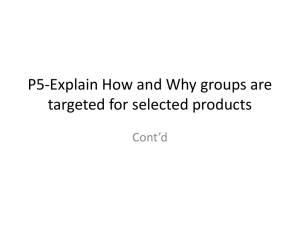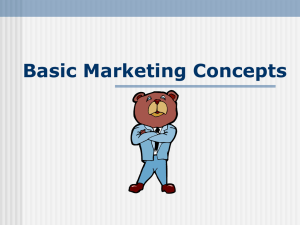
MARK2038
Data Base Marketing Strategies II
Week 1
Instructor: Santo Ligotti
Email: sligotti@gbrownc.on.ca
Today’s Agenda
Introductions
Housekeeping
Course outline, evaluation
Lecture
Direct & Database Marketing-Review
List Management
Handout Assignment #1
Review of Direct &
Database Marketing
Learning Objectives
1.
2.
To review what direct marketing is and how
it differs from mass marketing;
To understand its importance in
contemporary marketing.
This week
DM review
Compare DM to advertising
DM agencies, suppliers and associations
Review customer segmentation,
targeting, positioning
Assignment 1 handout
Are you familiar with these
brands? Why?
8
Direct Marketing
“Any direct communication to a consumer or
business recipient, that is designed to
generate a response in the form of an order
(direct order), a request for further
information (lead generation), and/or a visit
to a store or other place of business for
purchase of a specific product(s) or service(s)
(traffic generation).”
The Direct Marketing Association (DMA)
Alternate Definitionuse of
interaction
media
with customers
(Stone)
The interactive use of advertising media,
to stimulate an immediate behaviour
that can be tracked, recorded, analyzed
and stored on a database for future
retrieval and use.
stored on a
database
measurable
results
In Other Words…
The purpose of direct marketing is to
communicate with customers in a way
that elicits response, which ultimately
adds to…
profit.
Direct Marketing
use of
media
Campaign
interaction
with customers
Marketer
Fulfillment
measurable
results
Response
stored on a
Customer
database
Database Marketing
•
Database Marketing: the discipline of continuously aggregating,
interpreting, analyzing, and applying information about
customers and prospects to achieve business objectives.
•OR
Direct marketing is a way of acquiring and keeping
customers by providing a framework for three activities:
analysis of individual customer information
strategy formation
implementation such that customers respond directly
In this course, the terms “direct marketing” and “database
marketing” are interchangeable
It began with Mass Marketing...
Mass Marketing: A method of reaching
millions of people to tell them about
available products and services.
predominated from 1950 to 1980
growth of television created mass audiences for national advertising
mass marketing makes mass production possible: lower prices,
improved quality, higher disposable incomes
mass marketing losing effectiveness for some products
most people have the basics
media fragmentation
Database marketing enables a 2way dialogue with one consumer
Mass Marketing
Database Marketing
Targeting to Many
Targeting to ‘One’
13
Key Differences Mass vs. Direct Marketing
Mass
Directed at many via mass media
Generic communications
Highly visible to competition
In general, no clear action
communicated: designed to drive
awareness, change attitudes,
behaviour
Effectiveness tough to measure
“Noise” reduces effectiveness
Direct
Targeted to individual, valuable
customers via direct marketing
Customized communications
Less visible to the competition
Clear ‘call-to-action’ requested
Results are measurable
Almost “noise-free”
Do you think mass marketing will eventually “cease to exist”?
Key Differences Mass vs. Direct Marketing
Mass marketing
build a brand and advertise it
distribution to retail
customer initiates buying
Direct marketing
get to know customer because you start recording
your transactions with them
maybe distribute direct
company initiates contact
Database Marketing
Why use Database
Marketing?
Five typical applications:
1.
2.
3.
4.
5.
Use profiles to find more loyal and
responsive prospects
Increase customer retention rate, or
repurchase rate
Increase referrals
Increase cross-selling and up-selling
Decrease marketing costs
Questions that DBM can
answer:
Which customers are profitable now?
Which customers could be more profitable
over time?
Why are my customers leaving?
What channels do customers prefer to buy
through?
How do I know when and what products to
up-sell / cross-sell?
Three levels of Direct Marketing
Direct marketing drives the business: “stand alone”
E.g. ING DIRECT, BELAIRdirect
Direct marketing drives part or all of the marketing
strategy: integrated
E.g. traditional banks
Direct marketing is used within the
communications mix
Peripheral
E.g. mailing lists of small retailers
Three levels of Direct Marketing
DM
1. ‘Stand alone’
2. Integrated
DM
DM
3. ‘Peripheral
Reasons for Growth
More demanding, time-poor consumers
women make up higher % of workforce
less time to spend on purchase decisions:
DM is personal and targeted so saves time
Decline in brand loyalty
excessive price reductions, increasing
retailer power, brand proliferation
with DM, identify best customers and
reward loyalty
Reasons for Growth cont.
Proliferation of media
media fragmentation makes it difficult to reach
customers by traditional media
growth opportunities for DM because a cost
effective means of reaching customers
Demand for accountability
often easier to measure effectiveness of DM
tactics vs. traditional mass marketing tactics
Changing technology
continuing drop in computer processing costs
Internet
Core Concepts of Direct
Marketing
Customer-based, not product-based
Individualized: High Customer Involvement
Targeted vs. wide reaching
Attract Relationship Buyers, Detract Transaction Buyers
Focus on Retention vs. Acquisition
Focus: Share of ‘Customer’ or ‘Wallet’ vs. Share of
‘Market’
Measurability: Test & Learn Approach
Information-intensive
Long-term oriented
Industries that have adopted
DM
Telecommunications / Technology
Financial services
Automotive
Retail
Publishing
Travel & entertainment
Non profit / charities
Consumer packaged goods
Pharmaceutical
Can you think of some examples from each industry?
What job opportunities exist?
Direct Response Ad Agencies
Account Executives, Copywriters, Media Planners & Buyers
List Brokers, List Compilers
Telemarketing , Internet
Account Executives, Script Writers, Centre Managers, Trainers
Printers
Fulfillment
Hardware, Software vendors
Financial Services Companies including banks, and insurance
organizations
Retail Services Industries (bricks and mortar stores, on-line stores)
Data Analyst Roles
Strategy Development
Database Management
Relationship Marketing
Relationship marketing uses customer databases
to record individual characteristics and preferences.
Targets individual customers according to
their specific needs, and building
customer loyalty.
Marketers find or create products and experiences tailored
to
delight individual customers (rather than the opposite).
Relationship Marketing
•It is the core business strategy that integrates
internal processes and functions and external
networks to create and deliver value to targeted
customers at a profit. It is grounded on high-quality
customer data and enabled by information
technology
F.Buttle, “Customer Relationship Management
The 3 Direct Marketing
Variables
Creative
Offer
Media
The 3 DM Variables: Creative
Creative: the “packaging” of the offer
in terms of:
1.
2.
3.
Copy
Layout (design)
Theme
The 3 DM Variables: Media
Direct-response media include:
Direct mail
Telemarketing
Print
Broadcast
Digital media
Some are affinity channels, some are not.
The 3 DM Variables: Offer
Offer: the promise of the transaction,
communicating the benefits of
purchase in terms of:
The product or service itself
Price
Payment terms
Guarantee
Incentives
Strategy
Corporate/ BU
Strategy
Marketing
Strategy
Where, when and
how promotional
expenditures will
be made
IMC
Strategy
Technology
Strategy
Database
Marketing
Strategy
Campaign A
Campaign B
Vision/Mission
Situation Analysis
Competitive Strategy
Objectives
Target markets
Marketing mix
Resources
Creative
Brief
Customer insight
USP
Messages
Programs
(strategic)
Campaign C
Campaigns
(tactical)
RECALL: Setting Direct
Marketing Strategy
Objectives
•
What are you trying to achieve?
Strategy
How are you are going to achieve your objectives?
• Are generally broad statements about the approach you are
going to take to your business
• Strategies provide direction – a set of guidelines which
guide your actions
•
Tactics
•
Individual campaigns / programs intended to implement the
strategy
Typical Marketing Strategies
1.
2.
3.
4.
5.
6.
Create new profit centers
Launch new products
Maximize after-market
sales
Lead generation
Drive retail traffic
Develop niche markets
Marketing Plan
Marketing Plan: A document that
communicates marketing objectives,
activities and resources.
Purpose of a marketing plan
Sets objectives for sales, profit, market share,
new customers, timelines
Outlines the target segments and consumer
behaviour
Specifies the competition and other
environmental variables
Product, pricing, promotion, distribution
Specifies the measurement activities
Provides a formal review process
Marketing Plan Elements
1. Introduction
2. Executive Summary
3. Situation Analysis (SWOT)
a)
b)
c)
d)
e)
f)
Market environment
Competitive situation
Target group analysis (segmentation)
Distribution channels
Product situation
Research
Marketing Plan Elements
(cont’d)
4.
5.
6.
Opportunity and Issue Analysis
Objectives
Marketing Strategy
1.
2.
3.
7.
8.
9.
IMC strategies
Creative brief
Technology strategy (data brief)
Campaigns (tactics)
Metrics
Budget
Objective Setting
GENERIC
SPECIFIC
Increase market share
Increase share of market
from 12% to 15% (in Q4)
Increase sales revenue
Increase sales revenue by
10% to $110MM (in Q4)
Maintain prices
Maintain an average price of
$72.00 per unit thru Q4
Increase margin
Achieve a gross margin profit
of 40% (in Q4)
Generate leads
Generate 1200 new leads in
Q4
Segmentation
A Segment is:
A group of customers or prospects with similar
characteristics that you have identified for
marketing purposes.
Segmentation is:
The process of dividing larger customer groups
into profile groups (or segments) based on one or
more meaningful characteristics for targeted
marketing purposes.
Direct your marketing dollars to where they will
do the most good.
28
Segmentation
1.
2.
3.
Group customers that respond
similarly to various marketing
treatments.
Establish & refine segments as
ongoing points of reference in your
business.
Segments must be profitable to serve.
Segmentation Methods
1.
2.
3.
4.
5.
6.
Geographic
Demographic
Geo-demographic
Psychographic
Attitudinal
Behavioural
…or some combination of the above
Segmentation: Data Types
Purchase behaviour data
Segment by customer value (LTV)
Segment by customer need
Profile data
Target existing customers – identify those most likely to
respond (ROI-driven marketing)
Target new customers more accurately
30
Segmentation: Data Types
Segmentation is based on 2 main types of data
Behavioural (purchase) data-such as what banks and
retailers like Shoppers Drug Mart do (OPTIMUM
CARD)
Profile data (consumer characteristics)DEMOGRAPHICS or PSYCHOGRAPHICS (Lifestyle
attributes)
30
Segmentation Applications &
Techniques in Direct Marketing
Application
Technique
Setting budgets
LIFE TIME VALUE (LTV)
Understanding customers’ value to you
RFM (RECENCY, FREQUENCY,
MONETARY), LTV
Understanding existing customers as
individuals: what they want from you
Database overlays with external data;
profiling/modelling techniques
Targeting your spend in order to
maximize ROI per campaign
Modelling techniques, RFM
Profiling existing customers in order to
target new customers
Profiling/modelling techniques
Principles of Direct and Database Marketing, 3 rd Ed., Alan Tapp, pg 58.
Discovering opportunities
Data Mining
•
•
•
is the process of using statistical analysis to detect relevant patterns
and trends in purchasing behavior in a database
requires task-appropriate software to sift through massive quantities
of data
helps transform data into marketing information, e.g.:
develop models that predict future purchase behavior based on
past purchases
determine response to marketing programs
help forecast sales
allows for creation of customer profiles
Some Commonly Used Statistical
Procedures and Software for DM
Statistical Procedures
Regression Analysis
Cluster Analysis
Discriminant Analysis
Factor Analysis
CHAID (Chi-square automatic interaction
detection)
Segmentation Applications
Segment by customer value
Not all customers are created equal - most sales are to a
minority of customers
PARETO Principle: For most companies the 80/20 rule
applies: 20% of customers account for 80% of profits
Goal : increase profitability by identifying and focusing on
that 20% of customers
How much are your customers worth today, their lifetime
value (present value of future profits), or their potential
value (future growth) given growth
30
Segmentation Applications: LTV
Lifetime Value (LTV)
Calculate how much profit each customer is likely to be
worth to the company
Focus marketing strategy
Determine allowable marketing spend
What it really means is that throughout the time that a
customer spends with you, they will generate revenue for
you
That revenue generated over those years is essentially
their lifetime value
You can determine, what the value of that customer is
today, given how long they will stay, this is all you need to
understand about LTV
30
Customer Value Dictates
Strategy
Best Customers (MVCs)
20% of Customers
80% of Revenue
Best hope
for new GOLD customers
Worst Customers
50% of Customers
1% of Total Revenue
Source: Strategic Database Marketing, A. Hughes
GOLD
Objective: Retain
Spend Service Dollars
Here
Move up
Objective: Grow
Spend Marketing
Dollars Here
Unprofitable
Objective: Drop or
make Profitable
Reprice, move up,
lose
Segmentation Applications
Segment by customer need
Quite common in marketing to segment by customer
need
Helps to understand the benefits obtained by different
sets of consumers from the same product
How:
Market Research
In house information from your warehouse
External psychographic or demographic information (PSYTE)
30
Customer Profiling
Customer profiles
a way of identifying possible new prospects for your
company
Divide customer base into segments with similar
attributes: purchase behaviour, demographics, lifestyle
Works on the principle that our best prospects are like
our existing customers
30
Customer Profiling-Helps Find
the Low Hanging Fruit
GET IT?
High $
Low $
Customer Profiling
Various ways to create customer profiles, e.g.:
– Demographics
– Cluster Analysis
30
Customer Profiling:
Demographics
What are Demographics?
•
•
Facts about people that describe who they are and that we
can determine, measure and record
e.g. - income, age, presence of children, housing, sex,
marital status type of car, occupation etc.
Sources
• Surveys - ask questions on satisfaction surveys, application
forms, contests etc.
• Applicant data - banks, insurance, credit card companies
Customer Profiling: Cluster
Analysis
•
•
Data is searched to find natural groupings, the members
of each group having more in common with each other
than they do with members of other groups e.g.:
– parents of babies
– sports enthusiasts
– people who read: fiction vs. biographies
Software suggests additional purchases that would likely
appeal to a customer based on what others in the
segment have bought
Customer Profiling: Cluster
Analysis
Applications - e.g.:
• Bank
- have teller display screens suggest “next product”
• Department store - identify households that buy cribs and
strollers and target them for baby clothes and infant toys
• Start thinking about relationships that might not be obvious
- e.g., a U.S. company that sells wine direct discovered:
Champagne buyers are more likely to add glassware,
chocolates or gift items to their order
Red wine buyers more likely to take advantage of full case
discounts
Buyers of California wine are more likely to add other
California wines to their order
Major Industry Roles
Marketers
(Clients)
Suppliers
Agencies
•Brand/Category
Management
•Account Executives/
Supervisors/ Directors
•Media
•Regional Management
•Creative Services/
Copywriters/ Art Directors
•List houses
•Segment Management
•Global Management
•Media measurement
•Research Services
•Fulfillment houses
•Production
•Technology
vendors/integrators
•Media Planners/ Buyers/
Supervisors
•Data Processing services
Review of Key Terms
Direct marketing:
•
The interactive use of media to stimulate customer
response that can be measured and stored using
database technology.
Relationship (1-to-1) marketing:
Marketing messages specifically tailored for
individual customers based on information about
their preferences and purchases contained in an
individual’s database record.
Review of Key Terms
(cont’d)
LTV:
Net present value of all future profits to be
realized on the average new customer during a
given number of years.
Lead generation:
Direct marketing activity designed to invite
inquiries for sales follow-up.
Review of Key Terms
(cont’d)
Direct mail:
a direct marketing medium
Direct-response advertising:
The use of traditional advertising media as a
carrier vehicle for a direct marketing message.
True/False
Database technology allows marketers
to create a different marketing mix for
each target segment. (T/F)
True/False
Sustainable competitive advantage
comes from making products or
services that are very similar to those
sold by competitors. (T/F)
True/False
Alternative direct marketing plans are
best evaluated by the amount of sales
volume they are expected to generate.
(T/F)
True/False
Marketers should take advantage of all
opportunities they see in the
marketplace. (T/F)
True/False
Given that a marketing plan consists of
forecasts and estimates, management
will never really know if a plan is
successful even well after it has been
executed. (T/F)
Multiple Choice
Marketing objectives are usually classified
in terms of:
A)
B)
C)
D)
Timelines
Market share
Financial targets
All of the above.
It all starts with the list
A list is a collection of names and addresses
used by direct marketers to target offers.
The list determines:
WHO will ultimately receive your message
The total number of interactions possible for the
campaign
The total projected revenue from the campaign
List Types and Sources
House
Lists
Internal
Combined
List
Renter
A
Response
Lists
Renter
B
Renter
C
Compiled
Lists
House Lists
House List: an internal list compiled from
internal customer records.
Can contain purchase data and purchase patterns
A valuable asset
House lists can be “bartered” (traded) with
strategic partners
House List Sources
accounting records
shipping records
records of inquiries
warranty cards
survey research results
Response Lists
Response List: an external list made up of
individuals who have already exhibited a type
of interaction desired by the firm.
= “Another firm’s house list”
Examples:
Buyer lists
Attendee/Membership/Seminar Lists
Subscription lists
Donor lists
Compiled Lists
Compiled List: an external list that includes
records without any previous indication of
willingness to respond, but with some defined
characteristics.
Examples:
Consumer compiled list
Consumer lifestyle-enhanced list
Business compiled list (directories)
Example: InfoUSA
BusinessUSA:
HouseholdsUSA:
Physicians & Surgeons:
Big Businesses:
Manufacturers:
Small Business Owners:
.
14 million businesses
200 million households
732,000 physicians
218,000 top firms
612,000 manufacturers
4.5 million
Discuss
If you were purchasing a single
response list for an upcoming direct
mail campaign, which one would you
choose?
List A: bought a similar product
List B: bought within the category
List C: bought something by mail
Affinity
bought an identical product by mail
bought a similar product by mail
inquired about your product
bought within the category
bought something by mail
any other action by mail
Affinity – Another Perspective
Most
Effective
Least
Effective
• Active Customers
(bought in last x months)
• Inactive Customers
(bought in > x months)
• Former Customers
• Select Prospects
(high propensity to buy)
• Other Prospects
RFM
Case Study – CAA
In your new job as a
direct marketer at
the CAA, you are
responsible for
building
membership.
What are some
potential list
sources?
List Management
The role of list managers
Selection criteria
Seeding
Data hygiene
List Management Roles
List renter: the list “buyer”
List compiler: the company or person who
compiles the list
List broker: an intermediary who:
Maintains list hygiene and suppression
Provides recommendations, discounts, etc.
Typically paid on a commission basis
Selection Criteria
When was the list last updated?
How deliverable is the list? (hygiene)
What selections are available, and at what cost?
What is the source of the list?
Is the list owner a member of the CDMA?
What is the rollout potential of the list compared
to rollout fees?
Size and turnover
Selection Criteria - Costs
“Premium” lists contain:
Recently verified contacts (30-90 days)
Proven mail-order buyers
Contacts with highly detailed profiles
Hard-to-find customer data
“Bargain” lists contain:
Unconfirmed contacts
Inquired instead of purchased
Names/addresses only
Seeding
Seeding: a common practice by list
compilers/brokers of adding disguised
names and addresses to monitor list
usage.
Data Hygiene
Data hygiene: business processes that
maintain the usability of customer data.
Reasons:
Non-standard/missing address data
Incorrect Name
Titles, Gender
Duplication
Inappropriate
Gone away, died
Demonstration - InfoUSA
Use the InfoUSA web
site to investigate how
many small retail
stores could be
targeted in the
Manhattan area.
Selections:
Under 20 employees
“Excellent” or “Very
Good” credit rating
Toronto-GTA area (area
code 416,905,647)
Homework …
Sign up for an industry e-newsletter
www.1to1.com
www.dmn.ca
www.crmcommunity.com
Peppers & Rogers Consulting
Direct Marketing News
CRM Community
• Determine group for Group Project
• Start working on Assignment 1
• Reading
• Today covered Chapter 1, 2 and 3 in TAPP textbook
• Next week: Chapters 10, 11, and 12 in TAPP textbook, Stone pp. 37-44
• READ the DMN Article handed out in class; “Is it Possible to change public perception
of direct marketers as junk mailers, if so how?”. Be prepared to discuss in class next
week:
http://www.dmn.ca/Articles/Articles/2004/readerforum1.htm









